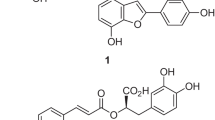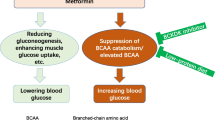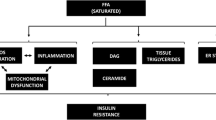Abstract
Obesity has become a public health epidemic worldwide and is associated with many diseases with high mortality including hypertension, diabetes, and heart disease. High-fat diet (HFD)-induced energy imbalance is one of the primary causes of obesity, but the underlying mechanisms are not fully elucidated. Our study showed that HFD reduced the level of hydrogen sulfide (H2S) and its catalytic enzyme cystathionine β-synthase (CBS) in mouse hypothalamus and plasma. We found that HFD activated mTOR, IKK/NF-κB, the main pathway regulating inflammation. Activation of inflammatory pathway promoted the production of pro-inflammatory cytokines including IL-6, IL-1β, and TNF-α, which caused cell damage and loss in the hypothalamus. The disturbance of the hypothalamic neuron circuits resulted in body weight gain in HFD-induced mice. Importantly, we also showed that restoration of H2S level with NaHS or activation of CBS with SAMe attenuated HFD-induced activation of mTOR, IKK/NF-κB signaling, which reduced the inflammation and the neuronal cell loss in the hypothalamus, and also inhibited body weight gain in mice. The same effects were obtained by inhibiting mTOR or NF-κB, which suggested that mTOR and NF-κB were the critical molecular factors involved in hypothalamic inflammation. Taken together, this study identified that HFD-induced hypothalamus inflammation plays a critical role in the development of obesity. Moreover, the inhibition of hypothalamic inflammation by regaining H2S level could be a potential therapeutic to prevent the development of obesity.
Graphical abstract







Similar content being viewed by others
Data Availability
The authors declare that all data supporting the findings of this investigation are available within the article, its supplementary information, and from the corresponding authors upon reasonable request.
Abbreviations
- HFD:
-
High-fat diet
- ND:
-
Normal diet
- CBS:
-
Cystathionine β-synthase
- SAMe:
-
S-Adenosyl-L-methionine
- mTOR:
-
Mammalian target of rapamycin
- RPM:
-
Rapamycin
- IKKβ:
-
Inhibitory κB kinase-beta
- IκBα:
-
Inhibitor κB-alpha
- NF-κB:
-
Nuclear factor-κB
- PDTC:
-
Pyrrolidine dithiocarbamate
- IL-1β:
-
Interleukin-1 beta
- IL-6:
-
Interleukin-6
- TNF-α:
-
Tumor necrosis factor-alpha
- qPCR:
-
Quantitative real-time PCR
- ANOVA:
-
One-way analysis of variance
References
Bray GA (1985) Complications of obesity. Ann Intern Med 103:1052–1062. https://doi.org/10.7326/0003-4819-103-6-1052
Goodarzi MO (2018) Genetics of obesity: what genetic association studies have taught us about the biology of obesity and its complications. Lancet Diabetes Endocrinol 6:223–236. https://doi.org/10.1016/S2213-8587(17)30200-0
Heffron SP, Parham JS, Pendse J, Alemán JO (2020) Treatment of obesity in mitigating metabolic risk. Circ Res 126:1646–1665. https://doi.org/10.1161/CIRCRESAHA.119.315897
Zheng Z-G, Zhu S-T, Cheng H-M, Zhang X, Cheng G, Thu PM, Wang SP, Li H-J et al (2021) Discovery of a potent SCAP degrader that ameliorates HFD-induced obesity, hyperlipidemia and insulin resistance via an autophagy-independent lysosomal pathway. Autophagy 17:1592–1613. https://doi.org/10.1080/15548627.2020.1757955
Karnani M, Burdakov D (2011) Multiple hypothalamic circuits sense and regulate glucose levels. Am J Physiol Regul Integr Comp Physiol 300:R47–R55. https://doi.org/10.1152/ajpregu.00527.2010
Velloso LA, Schwartz MW (2011) Altered hypothalamic function in diet-induced obesity. Int J Obes (Lond) 35:1455–1465. https://doi.org/10.1038/ijo.2011.56
van de Sande-Lee S, Velloso LA (2012) Hypothalamic dysfunction in obesity. Arq Bras Endocrinol Metabol 56:341–350. https://doi.org/10.1590/S0004-27302012000600001
de Git KC, Adan RA (2015) Leptin resistance in diet-induced obesity: the role of hypothalamic inflammation. Obes Rev 16:207–224. https://doi.org/10.1111/obr.12243
De Souza CT, Araujo EP, Bordin S, Ashimine R, Zollner RL, Boschero AC, Saad MJ, Velloso LA (2005) Consumption of a fat-rich diet activates a proinflammatory response and induces insulin resistance in the hypothalamus. Endocrinology 146:4192–4199. https://doi.org/10.1210/en.2004-1520
Morton GJ, Cummings DE, Baskin DG, Barsh GS, Schwartz MW (2006) Central nervous system control of food intake and body weight. Nature 443:289–295. https://doi.org/10.1038/nature05026
Valdearcos M, Douglass JD, Robblee MM, Dorfman MD, Stifler DR, Bennett ML, Gerritse I, Fasnacht R et al (2018) Microglial inflammatory signaling orchestrates the hypothalamic immune response to dietary excess and mediates obesity susceptibility. Cell Metab 27:1356. https://doi.org/10.1016/j.cmet.2018.04.019
Thaler JP, Yi CX, Schur EA, Guyenet SJ, Hwang BH, Dietrich MO, Zhao X, Sarruf DA et al (2012) Obesity is associated with hypothalamic injury in rodents and humans. J Clin Invest 122:153–162. https://doi.org/10.1172/JCI59660
Hu L-F, Lu M, Hon Wong PT, Bian J-S (2011) Hydrogen sulfide: neurophysiology and neuropathology. Antioxidants & redox signaling 15:405–419. https://doi.org/10.1089/ars.2010.3517
Zhou Y-F, Wu X-M, Zhou G, Mu M-D, Zhang F-L, Li F-M, Qian C, Du F et al (2018) Cystathionine β-synthase is required for body iron homeostasis. Hepatology (Baltimore, Md.) 67:21–35. https://doi.org/10.1002/hep.29499
Whiteman M, Gooding KM, Whatmore JL, Ball CI, Mawson D, Skinner K, Tooke JE, Shore AC (2010) Adiposity is a major determinant of plasma levels of the novel vasodilator hydrogen sulphide. Diabetologia 53:1722–1726. https://doi.org/10.1007/s00125-010-1761-5
Zheng F, Han J, Lu H, Cui C, Yang J, Cui Q, Cai J, Zhou Y et al (1864) Cystathionine beta synthase-hydrogen sulfide system in paraventricular nucleus reduced high fatty diet induced obesity and insulin resistance by brain-adipose axis. Biochim Biophys Acta Mol Basis Dis 2018:3281–3291. https://doi.org/10.1016/j.bbadis.2018.07.014
M. Liu, M. Deng, J. Su, Y. Lin, Z. Jia, K. Peng, F. Wang, T. Yang. (2018)Specific downregulation of cystathionine β-synthase expression in the kidney during obesity, Physiological reports 6 e13630. https://doi.org/10.14814/phy2.13630
Sun H-J, Wu Z-Y, Nie X-W, Wang X-Y, Bian J-S (2021) Implications of hydrogen sulfide in liver pathophysiology: mechanistic insights and therapeutic potential. J Adv Res 27:127–135. https://doi.org/10.1016/j.jare.2020.05.010
Yang S-B, Tien A-C, Boddupalli G, Xu AW, Jan YN, Jan LY (2012) Rapamycin ameliorates age-dependent obesity associated with increased mTOR signaling in hypothalamic POMC neurons. Neuron 75:425–436. https://doi.org/10.1016/j.neuron.2012.03.043
Vinnikov IA, Hajdukiewicz K, Reymann J, Beneke J, Czajkowski R, Roth LC, Novak M, Roller A et al (2014) Hypothalamic miR-103 protects from hyperphagic obesity in mice, The Journal of Neuroscience : the Official Journal of the Society For. Neuroscience 34:10659–10674. https://doi.org/10.1523/JNEUROSCI.4251-13.2014
André C, Catania C, Remus-Borel J, Ladeveze E, Leste-Lasserre T, Mazier W, Binder E, Gonzales D et al (2018) mTORC1 pathway disruption abrogates the effects of the ciliary neurotrophic factor on energy balance and hypothalamic neuroinflammation. Brain Behav Immun 70:325–334. https://doi.org/10.1016/j.bbi.2018.03.014
Ben J, Jiang B, Wang D, Liu Q, Zhang Y, Qi Y, Tong X, Chen L et al (2019) Major vault protein suppresses obesity and atherosclerosis through inhibiting IKK-NF-κB signaling mediated inflammation. Nat Commun 10:1801. https://doi.org/10.1038/s41467-019-09588-x
Napetschnig J, Wu H (2013) Molecular basis of NF-κB signaling. Annu Rev Biophys 42:443–468. https://doi.org/10.1146/annurev-biophys-083012-130338
Benzler J, Ganjam GK, Pretz D, Oelkrug R, Koch CE, Legler K, Stöhr S, Culmsee C, Williams LM et al (2015) Central inhibition of IKKβ/NF-κB signaling attenuates high-fat diet-induced obesity and glucose intolerance. Diabetes 64:2015–2027. https://doi.org/10.2337/db14-0093
Dalvi PS, Chalmers JA, Luo V, Han DY, Wellhauser L, Liu Y, Tran DQ, Castel J et al (2005) High fat induces acute and chronic inflammation in the hypothalamus: effect of high-fat diet, palmitate and TNF-α on appetite-regulating NPY neurons. Int J Obes 41(2017):149–158. https://doi.org/10.1038/ijo.2016.183
Seong J, Kang JY, Sun JS, Kim KW (2019) Hypothalamic inflammation and obesity: a mechanistic review. Arch Pharmacal Res 42:383–392. https://doi.org/10.1007/s12272-019-01138-9
Xu T, Liu J, Li X-R, Yu Y, Luo X, Zheng X, Cheng Y, Yu P-Q et al (2021) The mTOR/NF-κB pathway mediates neuroinflammation and synaptic plasticity in diabetic encephalopathy. Mol Neurobiol. https://doi.org/10.1007/s12035-021-02390-1
X Li P Yu Y Yu T Xu J Liu Y Cheng X Yang X Cui et al C Yin Y Liu 2021 Hydrogen sulfide ameliorates high glucose-induced pro-inflammation factors in HT-22 cells: Involvement of SIRT1-mTOR/NF-κB signaling pathway IntImmunopharmacol 95 107545 https://doi.org/10.1016/j.intimp.2021.107545
Han Y, Wu J-Z, Shen J-Z, Chen L, He T, Jin M-W, Liu H (2017) Pentamethylquercetin induces adipose browning and exerts beneficial effects in 3T3-L1 adipocytes and high-fat diet-fed mice. Sci Rep 7:1123. https://doi.org/10.1038/s41598-017-01206-4
Ozturk K, Tasci I, Yasar M, Akay C, Alcigir M, Vural S, Mas MR, Turker T et al (2015) Effects of rapamycin treatment on pancreatic fibrosis, cellular apoptosis and oxidative stress in experimental chronic pancreatitis model. Acta Gastroenterol Belg 78:3–7
Wang H, Xu L, Zhao J, Wang D, Guo R, Wang J, Gong W, Liu T et al (2014) Regulatory mechanism of pyrrolidine dithiocarbamate is mediated by nuclear factor-κB and inhibits neutrophil accumulation in ARDS mice. Exp Ther Med 8:614–622. https://doi.org/10.3892/etm.2014.1738
Zhao H, Pan P, Yang Y, Ge H, Chen W, Qu J, Shi J, Cui G et al (2017) Endogenous hydrogen sulphide attenuates NLRP3 inflammasome-mediated neuroinflammation by suppressing the P2X7 receptor after intracerebral haemorrhage in rats. J Neuroinflammation 14:163. https://doi.org/10.1186/s12974-017-0940-4
Fan J, Zheng F, Li S, Cui C, Jiang S, Zhang J, Cai J, Cui Q et al (2019) Hydrogen sulfide lowers hyperhomocysteinemia dependent on cystathionine γ lyase S-sulfhydration in ApoE-knockout atherosclerotic mice. Br J Pharmacol 176:3180–3192. https://doi.org/10.1111/bph.14719
Li M-D, Vera NB, Yang Y, Zhang B, Ni W, Ziso-Qejvanaj E, Ding S, Zhang K et al (2018) Adipocyte OGT governs diet-induced hyperphagia and obesity. Nat Commun 9:5103. https://doi.org/10.1038/s41467-018-07461-x
C. Zhang, C. Yue, A. Herrmann, J. Song, C. Egelston, T. Wang, Z. Zhang, W. Li, H. Lee, M. Aftabizadeh, Y.J. Li, P.P. Lee, S. Forman, G. Somlo, P. Chu, L. Kruper, J. Mortimer, D.S.B. Hoon, W. Huang, S. Priceman, H. Yu, STAT3. (2020)Activation-induced fatty acid oxidation in CD8 T effector cells is critical for obesity-promoted breast tumor growth, Cell Metab 31. https://doi.org/10.1016/j.cmet.2019.10.013
Baker RG, Hayden MS, Ghosh S (2011) NF-kappaB, inflammation, and metabolic disease. Cell Metab 13:11–22. https://doi.org/10.1016/j.cmet.2010.12.008
Moraes JC, Coope A, Morari J, Cintra DE, Roman EA, Pauli JR, Romanatto T, Carvalheira JB et al (2009) High-fat diet induces apoptosis of hypothalamic neurons. PLoS One 4:e5045. https://doi.org/10.1371/journal.pone.0005045
Jais A, Brüning JC (2017) Hypothalamic inflammation in obesity and metabolic disease. J Clin Investig 127:24–32. https://doi.org/10.1172/JCI88878
Tran DQ, Tse EK, Kim MH, Belsham DD (2016) Diet-induced cellular neuroinflammation in the hypothalamus: Mechanistic insights from investigation of neurons and microglia. Mol Cell Endocrinol 438:18–26. https://doi.org/10.1016/j.mce.2016.05.015
DeLegge MH, Smoke A (2008) Neurodegeneration and inflammation. Nutr Clin Pract 23:35–41. https://doi.org/10.1177/011542650802300135
Katsouda A et al (2018) Reduced adipose tissue H2S in obesity. Pharmacol Res 128:190–199. https://doi.org/10.1016/j.phrs.2017.09.023
Bahadoran Z et al. (2022) Association between serum hydrogen sulfide concentrations and dysglycemia: a population-based study. BMC Endocrine Disorders 22:1 79. https://doi.org/10.1186/s12902-022-00995-8
Zhang H, Huang Y, Chen S, Tang C, Wang G, Du J, Jin H (2021) Hydrogen sulfide regulates insulin secretion and insulin resistance in diabetes mellitus, a new promising target for diabetes mellitus treatment? A review, J Adv Res 27:19–30. https://doi.org/10.1016/j.jare.2020.02.013
Dilek N, Papapetropoulos A, Toliver-Kinsky T, Szabo C (2020) Hydrogen sulfide: an endogenous regulator of the immune system. Pharmacol Res 161:105119. https://doi.org/10.1016/j.phrs.2020.105119
S. Gheibi, S. Jeddi, K. Kashfi, A. Ghasemi. (2019)Effects of hydrogen sulfide on carbohydrate metabolism in obese type 2 diabetic rats, Molecules 24. https://doi.org/10.3390/molecules24010190
Luo Z-L, Ren J-D, Huang Z, Wang T, Xiang K, Cheng L, Tang L-J (2017) The role of exogenous hydrogen sulfide in free fatty acids induced inflammation in macrophages. Cellular physiol and biochem : international J experimental cellular physiology, biochemistry, and pharmacology 42:1635–1644. https://doi.org/10.1159/000479405
Zhang Q, Yuan L, Liu D, Wang J, Wang S, Zhang Q, Gong Y, Liu H et al (2014) Hydrogen sulfide attenuates hypoxia-induced neurotoxicity through inhibiting microglial activation. Pharmacol Res 84:32–44. https://doi.org/10.1016/j.phrs.2014.04.009
Song Y, Zhang F, Ying C, Kumar KA, Zhou X (2017) Inhibition of NF-κB activity by aminoguanidine alleviates neuroinflammation induced by hyperglycemia. Metab Brain Dis 32:1627–1637. https://doi.org/10.1007/s11011-017-0013-5
Douglass JD, Dorfman MD, Fasnacht R, Shaffer LD, Thaler JP (2017) Astrocyte IKKβ/NF-κB signaling is required for diet-induced obesity and hypothalamic inflammation, Molecular. Metabolism 6:366–373. https://doi.org/10.1016/j.molmet.2017.01.010
Santos LS, Cordeiro GS, Matos RJB, Perez GS, Silva RT, Boaventura GT, Barreto-Medeiros JM (2022) High-fat diet promotes hypothalamic inflammation in animal models: a systematic review. Nutr Rev 80:392–399. https://doi.org/10.1093/nutrit/nuab033
Li J, Li M, Li L, Ma J, Yao C, Yao S (2022) Hydrogen sulfide attenuates ferroptosis and stimulates autophagy by blocking mTOR signaling in sepsis-induced acute lung injury. Mol Immunol 141:318–327. https://doi.org/10.1016/j.molimm.2021.12.003
Wu D, Li J, Zhang Q, Tian W, Zhong P, Liu Z, Wang H, Wang H, Ji A, Li Y (2019) Exogenous hydrogen sulfide regulates the growth of human thyroid carcinoma cells. Oxid Med Cell Longev 2019:6927298. https://doi.org/10.1155/2019/6927298
Xu X, Li H, Gong Y, Zheng H, Zhao D (2018) Hydrogen sulfide ameliorated lipopolysaccharide-induced acute lung injury by inhibiting autophagy through PI3K/Akt/mTOR pathway in mice. Biochem Biophys Res Commun 507:514–518. https://doi.org/10.1016/j.bbrc.2018.11.081
Zhang D, Wang X, Chen S, Chen S, Yu W, Liu X, Yang G, Tao Y et al (2019) Endogenous hydrogen sulfide sulfhydrates IKKβ at cysteine 179 to control pulmonary artery endothelial cell inflammation. Clin Sci (Lond) 133:2045–2059. https://doi.org/10.1042/CS20190514
Xuan A, Long D, Li J, Ji W, Zhang M, Hong L, Liu J (2012) Hydrogen sulfide attenuates spatial memory impairment and hippocampal neuroinflammation in β-amyloid rat model of Alzheimer’s disease. J Neuroinflammation 9:202. https://doi.org/10.1186/1742-2094-9-202
Dai J, Jiang C, Chen H, Chai Y (2019) Rapamycin attenuates high glucose-induced inflammation through modulation of mTOR/NF-κB pathways in macrophages. Front Pharmacol 10:1292. https://doi.org/10.3389/fphar.2019.01292
Hou Y-C, Chiu W-C, Yeh C-L, Yeh S-L (2012) Glutamine modulates lipopolysaccharide-induced activation of NF-κB via the Akt/mTOR pathway in lung epithelial cells, American journal of physiology. Lung cellular and molecular physiology 302:L174–L183. https://doi.org/10.1152/ajplung.00066.2011
T. Liu, L. Zhang, D. Joo, S.-C. Sun. (2017) NF-κB signaling in inflammation, Signal Transduct Target Ther 2. https://doi.org/10.1038/sigtrans.2017.23
Tornatore L, Thotakura AK, Bennett J, Moretti M, Franzoso G (2012) The nuclear factor kappa B signaling pathway: integrating metabolism with inflammation. Trends Cell Biol 22:557–566. https://doi.org/10.1016/j.tcb.2012.08.001
Israël A (2010) The IKK complex, a central regulator of NF-kappaB activation. Cold Spring Harb Perspect Biol 2:a000158. https://doi.org/10.1101/cshperspect.a000158
Martiskainen H, Paldanius KMA, Natunen T, Takalo M, Marttinen M, Leskelä S, Huber N, Mäkinen P et al (2017) DHCR24 exerts neuroprotection upon inflammation-induced neuronal death. J Neuroinflammation 14:215. https://doi.org/10.1186/s12974-017-0991-6
Kimura Y, Kimura H (2004) Hydrogen sulfide protects neurons from oxidative stress, FASEB journal : official publication of the Federation of American Societies for. Exp Biol 18:1165–1167. https://doi.org/10.1096/fj.04-1815fje
Zhang L-M, Jiang C-X, Liu D-W (2009) Hydrogen sulfide attenuates neuronal injury induced by vascular dementia via inhibiting apoptosis in rats. Neurochem Res 34:1984–1992. https://doi.org/10.1007/s11064-009-0006-9
Li Z, Wang Y, Xie Y, Yang Z, Zhang T (2011) Protective effects of exogenous hydrogen sulfide on neurons of hippocampus in a rat model of brain ischemia. Neurochem Res 36:1840–1849. https://doi.org/10.1007/s11064-011-0502-6
Liu F-F, Zhao S, Liu P, Huo S-P (2019) Influence of mTOR signaling pathway on ketamine-induced injuries in the hippocampal neurons of rats. Neurol Res 41:77–86. https://doi.org/10.1080/01616412.2018.1531203
Shi Y, Liang X-C, Zhang H, Wu Q-L, Qu L, Sun Q (2013) Quercetin protects rat dorsal root ganglion neurons against high glucose-induced injury in vitro through Nrf-2/HO-1 activation and NF-κB inhibition. Acta Pharmacol Sin 34:1140–1148. https://doi.org/10.1038/aps.2013.59
Funding
This work was supported by the Open Research Project of Jiangsu Key Laboratory of Brain Disease Bioinformation (JSBL201802), the Open Research Project of Jiangsu Key Laboratory of Immunity and Metabolism (JSKIM201802), and the Science and Technology Planning Project of Xuzhou (KC20168).
Author information
Authors and Affiliations
Contributions
This work includes significant contributions from all authors. Yi Liu conceived the study and contributed to its experiment design. Maofang Zhao and Yuan Cheng contributed to the acquisition and analysis of the data and to the drafting of the manuscript. Xiaoxuan Wang and Xiaoying Cui contributed to the analysis of the data and to help the drafting of the manuscript. Qian Fu, Yilin Song, and Peiquan Yu help to collect the data. Yinghua Yu contributed to the revision of the manuscript. All authors read and approved the manuscript. Yi Liu is the guarantor of this work.
Corresponding author
Ethics declarations
Ethics Approval
All procedures were approved by the Animal Ethics Committee, Xuzhou Medical University, China, and complied with the National Institutes of Health Guidelines for the Care and Use of Laboratory Animals. License No.: SYXK (Shanghai) 2017–0008.
Consent to Participate
Not applicable for that section.
Consent for Publication
Not applicable for that section.
Competing Interests
The authors declare no competing interests.
Additional information
Publisher's Note
Springer Nature remains neutral with regard to jurisdictional claims in published maps and institutional affiliations.
Rights and permissions
Springer Nature or its licensor holds exclusive rights to this article under a publishing agreement with the author(s) or other rightsholder(s); author self-archiving of the accepted manuscript version of this article is solely governed by the terms of such publishing agreement and applicable law.
About this article
Cite this article
Zhao, M., Cheng, Y., Wang, X. et al. Hydrogen Sulfide Attenuates High-Fat Diet-Induced Obesity: Involvement of mTOR/IKK/NF-κB Signaling Pathway. Mol Neurobiol 59, 6903–6917 (2022). https://doi.org/10.1007/s12035-022-03004-0
Received:
Accepted:
Published:
Issue Date:
DOI: https://doi.org/10.1007/s12035-022-03004-0




